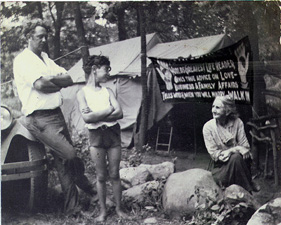"Gypsies" in the United States
Fortune-Telling Among the Rom & Romnichels
 Rom
Rom
The Rom arrived in the United States from
Serbia, Russia and Austria-Hungary beginning in the 1880's, part of the
larger wave of immigration from southern and eastern Europe in the late
19th and early 20th centuries. Primary immigration ended, for the most part,
in 1914, with the beginning of the First World War and subsequent tightening
of immigration restrictions (Salo and Salo 1986). Many people in this group
specialized in coppersmith work, mainly the repair
and retinning of industrial equipment used in bakeries, laundries, confectioneries,
and other businesses. The Rom, too, developed the fortune-telling business
in urban areas.
Two subgroups of the Rom, the Kalderash ("coppersmith") and Machwaya ("natives of Machva," a county in Serbia) appear in the photographs in Carlos de Wendler-Funaro's collection. De Wendler-Funaro identified some, but not all, Kalderash as "Russian Gypsies." Another group he identified as "Russian Gypsies" seem to be the Rusniakuria ("Ruthenians"), who in New York are known as musicians and singers.
Romnichels
The Romnichels, or English Gypsies, began to come to the United States from England in 1850. Their arrival coincided with an increase in the demand for draft horses in agriculture and then in urbanization, and many Romnichels worked as horse-traders. After the rapid decline in the horse trade following the First World War, most Romnichels relied on previously secondary enterprises, "basket-making," including the manufacture and sale of rustic furniture, and fortune-telling. Horse and mule trading continued to some extent in southern states where poverty and terrain slowed the adoption of tractor power (Salo and Salo 1982).